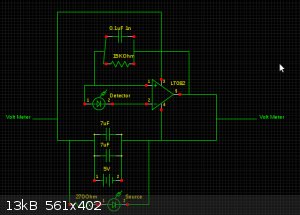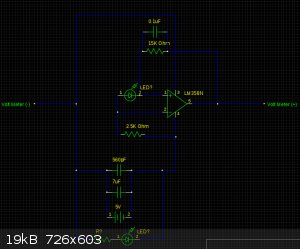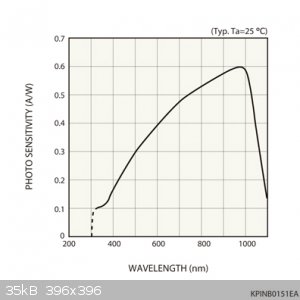| Pages:
1
2
3 |
aga
Forum Drunkard
    
Posts: 7030
Registered: 25-3-2014
Member Is Offline
|
|
Why is path-length important ?
If the LED and sensor are fixed, then the path-length will be the same each time between a Blank sample and the actual sample.
|
|
|
smaerd
International Hazard
    
Posts: 1262
Registered: 23-1-2010
Member Is Offline
Mood: hmm...
|
|
The path length is important in accordance to beer's law.
A = e * b * c where b is the path-length. It only really matters when it comes down to comparing results, or finding e (the molar extinction
coefficient).
Don't worry, I won't be publishing in nature any results I find taken by two LED's and a multimeter lol.
I don't really see how it's deceptive though, I mean, I half the concentration I get half the absorbance. I quarter the concentration I get a quarter
of the absorbance. It can't be off by that much. Actually I just used a little web app to calculate the P value of the result from the correlation
coefficient, the output says,
| Quote: | | The two-tailed P value is less than 0.0001. By conventional criteria, this difference is considered to be extremely statistically significant.
|
So I guess my P Value is okay as well. Physical Laws hold today!
[Edited on 28-5-2015 by smaerd]
|
|
|
blogfast25
International Hazard
    
Posts: 10562
Registered: 3-2-2008
Location: Neverland
Member Is Offline
Mood: No Mood
|
|
Quote: Originally posted by aga  | Why is path-length important ?
If the LED and sensor are fixed, then the path-length will be the same each time between a Blank sample and the actual sample. |
It improves inter-apparatus reproducibility, among other things.
|
|
|
aga
Forum Drunkard
    
Posts: 7030
Registered: 25-3-2014
Member Is Offline
|
|
So there must be a Standard path-length for a Colorimeter.
Anyone happen to know what that is ?
|
|
|
smaerd
International Hazard
    
Posts: 1262
Registered: 23-1-2010
Member Is Offline
Mood: hmm...
|
|
It doesn't have to be standard, it just has to be known. Most people use 1cm... C'mon Aga, look up the equation and understand it its really easy.
|
|
|
aga
Forum Drunkard
    
Posts: 7030
Registered: 25-3-2014
Member Is Offline
|
|
Maths ! Eeek !
I'll just build one and measure the path length.
|
|
|
blogfast25
International Hazard
    
Posts: 10562
Registered: 3-2-2008
Location: Neverland
Member Is Offline
Mood: No Mood
|
|
Laziness! Eeek!
This is well within your capabilities, Igor. Don't put Master to shame, please?
|
|
|
aga
Forum Drunkard
    
Posts: 7030
Registered: 25-3-2014
Member Is Offline
|
|
Egh ! Ugh ! Egh. Ooooh.
Yarm mahrster.
I shall see to it on the morn.
|
|
|
smaerd
International Hazard
    
Posts: 1262
Registered: 23-1-2010
Member Is Offline
Mood: hmm...
|
|
So I made a little amplification stage. It's stable but has a pretty big offset.
It's voltage goes from 3.42V-4.97V which is about a 5x gain on signal size but a considerable off-set. It at least would give decent values for a
microcontroller and could easily be improved on. Considering the op-amps cost about 0.25$ USD it's a pretty insignificant cost to factor in.
Also theres an error in my diagram, one of the 7uF cap's should be a 560pF cap.

[Edited on 28-5-2015 by smaerd]
|
|
|
smaerd
International Hazard
    
Posts: 1262
Registered: 23-1-2010
Member Is Offline
Mood: hmm...
|
|
Take back my previous amplification circuit. I changed the op-amp and added a new resistor from ground to the positive input. It now goes from 0-4.56V
Seems stable, should be good for a microcontroller. I'll probably use it for my analog only circuit.
Edit - the R? is 270 ohm
 ] ]
[Edited on 29-5-2015 by smaerd]
|
|
|
DistractionGrating
Hazard to Self
 
Posts: 68
Registered: 3-4-2014
Member Is Offline
Mood: Precipitated
|
|
I know this kit is more expensive than what is being discussed here, but I thought this link might be relevant in this thread. They have complete
plans available as well: http://www.iorodeo.com/content/educational-colorimeter-kit
|
|
|
smaerd
International Hazard
    
Posts: 1262
Registered: 23-1-2010
Member Is Offline
Mood: hmm...
|
|
Ah cool they are using one of the Light To Frequency detectors (http://www.mouser.com/ProductDetail/ams/TCS3200D-TR/?qs=07cg...). I wanted to buy one of those a while back. They are also using the RGB LED idea
which is pretty cool.
I like their design and the fact that they give premade enclosing materials and everything else. Very solid, I don't think I'd pay 85$ + an arduino
cost for one though. It's cool that they made a shield for the arduino to use their sensors for someone who wants to sort of lego something together.
Unfortunately I feel like a lot of the things they have in their design are just for appeal. Then again look at their soft-ware, its very feature rich
and cleanly made. The 85$ price tag is definitely fair, it's cool that someone at home made this. It's cheaper then many other commerical options.
Nice link.
I'm going for a 10-20$ build  . It won't have nearly as many output/processing
features though. . It won't have nearly as many output/processing
features though.
|
|
|
PHILOU Zrealone
International Hazard
    
Posts: 2893
Registered: 20-5-2002
Location: Brussel
Member Is Offline
Mood: Bis-diazo-dinitro-hydroquinonic
|
|
Quote: Originally posted by blogfast25  | Quote: Originally posted by aga  | Why is path-length important ?
If the LED and sensor are fixed, then the path-length will be the same each time between a Blank sample and the actual sample. |
It improves inter-apparatus reproducibility, among other things. |
Isn't inter-apparatus reproductibility influenced by the electronic behind and thus by each specific led, electronic part and circuit wiring
specificity?
--> Are 2 leds really identical in properties and reactivity?
I think the best is to get standard procedure for calibration for each individual apparatus.
I wonder what would be the result with a UV-Led...a friend of mine showed me one about 8-7 years ago (was expensive at that time)...must be much more
democratic by now.
This may require SiO2 cuvettes instead of glass for full potential.
By definition of smaerd principe exposed in the top of this tread UV-Led could be used with any of the 3 Led as detector (RGB) and maybe with a
combination of the 3.
If you make a window path perpendicular to the inital beam; then not only absorbance but also emission might be analysed  . .
[Edited on 5-6-2015 by PHILOU Zrealone]
PH Z (PHILOU Zrealone)
"Physic is all what never works; Chemistry is all what stinks and explodes!"-"Life that deadly disease, sexually transmitted."(W.Allen)
|
|
|
blogfast25
International Hazard
    
Posts: 10562
Registered: 3-2-2008
Location: Neverland
Member Is Offline
Mood: No Mood
|
|
Quote: Originally posted by PHILOU Zrealone  |
Isn't inter-apparatus reproductibility influenced by the electronic behind and thus by each specific led, electronic part and circuit wiring
specificity?
--> Are 2 leds really identical in properties and reactivity?
I think the best is to get standard procedure for calibration for each individual apparatus.
|
Inter-apparatus reproducibility is indeed affected by the whole apparatus, so path length included.
Each apparatus has to be calibrated for each specific analysis and frequently too.
|
|
|
smaerd
International Hazard
    
Posts: 1262
Registered: 23-1-2010
Member Is Offline
Mood: hmm...
|
|
PHILOU Zrealone - You are correct in a lot of ways. Not every LED has the same characteristics. So my LED colorimeter may be slightly more or less
sensitive in a range of concentrations then yours is. However, if both people take a measurement or a beers law plot on two different instruments, in
ranges that are proportional it doesn't matter. Ex, whether the first data point is 0.878mV and 0.645mV doesn't matter so long as concentration is
proportional to voltage. Absorbance units are dimensionless because they are only ever used as relative measurements. In fact this is common for all
spectroscopy.
As an undergrad one day I was tasked with testing colorimeters that general chemistry students reported as malfunctioning. So I devised beers law
experiments with 4 or five kinds of food coloring. Each colorimeter had slightly different values but ultimately functioned acceptably.
I do like your fluorescence idea. I was thinking along the same lines and that is why I selected the bracket that I did to hold the light sources. I
was going to use my 9W UV lamp as a source rather then a UV LED though. Edit- Actually the cuvette you see me using in the OP is a quartz cuvette I
purchased a long time ago to experiment with fluoresence and light scattering.
I wish I could edit my latest post in this thread. The schematic I drew up there isn't working as intended. It amplifies, but is insensitive to change
or really any kind. So I'll be updating that once I get time.
[Edited on 5-6-2015 by smaerd]
|
|
|
IrC
International Hazard
    
Posts: 2710
Registered: 7-3-2005
Location: Eureka
Member Is Offline
Mood: Discovering
|
|
Try using the AD8221, and a higher quality capacitor in the feedback loop, it may improve your circuit.
Quote: Originally posted by aga  | Why is path-length important ?
If the LED and sensor are fixed, then the path-length will be the same each time between a Blank sample and the actual sample. |
The sample itself will alter the actual path length compared to an empty cuvette by virtue of its Refractive index. Also this factor can bend light
out of the path lowering the incident light on the detector. I would rather use something like the BPW34 instead of a red LED as a detector in the
circuit. Since total flux incident on the detector is important I wonder if putting the detector at the focus of a parabolic reflector would improve
the system. I was thinking about the differing refraction of various samples shifting light away from the detector (by differing amounts depending
upon sample) on this last point.
"Science is the belief in the ignorance of the experts" Richard Feynman
|
|
|
aga
Forum Drunkard
    
Posts: 7030
Registered: 25-3-2014
Member Is Offline
|
|
Build one IrC !
Build. Build. Build.
|
|
|
IrC
International Hazard
    
Posts: 2710
Registered: 7-3-2005
Location: Eureka
Member Is Offline
Mood: Discovering
|
|
http://www.ebay.com/itm/Fire-Starter-Lighter-Parabolic-Solar...
What do you think, could this reflector be hardware hacked to work?
"Science is the belief in the ignorance of the experts" Richard Feynman
|
|
|
aga
Forum Drunkard
    
Posts: 7030
Registered: 25-3-2014
Member Is Offline
|
|
Thou jesteth surely ?
|
|
|
IrC
International Hazard
    
Posts: 2710
Registered: 7-3-2005
Location: Eureka
Member Is Offline
Mood: Discovering
|
|
I was considering the dual use since the apocalypse is almost upon us. How long can we trust the power grid we use to cook what we catch while living
in the wild. When not performing experimental measurements we could be fishing.
"Science is the belief in the ignorance of the experts" Richard Feynman
|
|
|
aga
Forum Drunkard
    
Posts: 7030
Registered: 25-3-2014
Member Is Offline
|
|
Farming on a small scale can be done in all situations.
|
|
|
blogfast25
International Hazard
    
Posts: 10562
Registered: 3-2-2008
Location: Neverland
Member Is Offline
Mood: No Mood
|
|
One turnip at a time.
|
|
|
IrC
International Hazard
    
Posts: 2710
Registered: 7-3-2005
Location: Eureka
Member Is Offline
Mood: Discovering
|
|
Anyway aga I was thinking of a large cell using a better detector, higher precision circuitry with lower offset. The parabolic reflector would work
for that. Say in a situation where steady flow of high volumes through a (large) cuvette section which measures any changes in production. Gasoline
refinery or something similar. That reflector could be taken apart and used to focus light on a BPW34 detector where monitoring of any changes in
composition was required. Whats wrong with that idea?
"Science is the belief in the ignorance of the experts" Richard Feynman
|
|
|
smaerd
International Hazard
    
Posts: 1262
Registered: 23-1-2010
Member Is Offline
Mood: hmm...
|
|
IrC there is nothing wrong with that idea. I just gave your idea shot using a LTC1050 op-amp and a BPW-34 photodiode with ~10x gain in TIA mode. (No
parabolic reflector or long sample path though). My +/-1% accuracy digital voltage display(~3$) gave me another nice linear fit (R^2 = 0.997) with a
populace of 4 samples! The voltage output is a little low(0-1.25V), but the BPW-34 isn't too sensitive to green light (mostly for red light).
I'm gonna build this thing a little tupper-ware container house, put in a trimmer potentiometer(so I can raise the gain a liiitttle more or lower it
for longer wavelength light sources), and solder up the circuit
Do you know of any cheapy photodiodes like the BPW34 that cater more to the mid-visible range? I'd really like to increase the sensitivity for non-red
sources.
Edit - also I had a really hard time reverse biasing the LED to do anything other then be a schmitt trigger(0V or 5V almost only).
[Edited on 9-6-2015 by smaerd]
|
|
|
IrC
International Hazard
    
Posts: 2710
Registered: 7-3-2005
Location: Eureka
Member Is Offline
Mood: Discovering
|
|
If I had to choose I would try the S5821Si PIN photodiode from Hamamatsu.
http://www.hamamatsu.com/eu/en/product/category/3100/4001/41...
From the above link the spectral response:

From the graph the green is roughly half the IR but still a decent choice.
This one may be even better, S10784.
http://www.ebay.com/itm/Hamamatsu-S10784-Silicon-PIN-Photodi...
Attachment: s10783_s10784_kpin1079e01.pdf (2.7MB)
This file has been downloaded 589 times
Attachment: HamaNews_0208.pdf (4MB)
This file has been downloaded 904 times
http://hamamatsu.advante.ru/catalog/997/1001.html
This page is useful since you can quickly scan specs and device number.
[Edited on 6-10-2015 by IrC]
"Science is the belief in the ignorance of the experts" Richard Feynman
|
|
|
| Pages:
1
2
3 |